2007 CHEVROLET TRAIL BLAZER flat tire
[x] Cancel search: flat tirePage 384 of 574
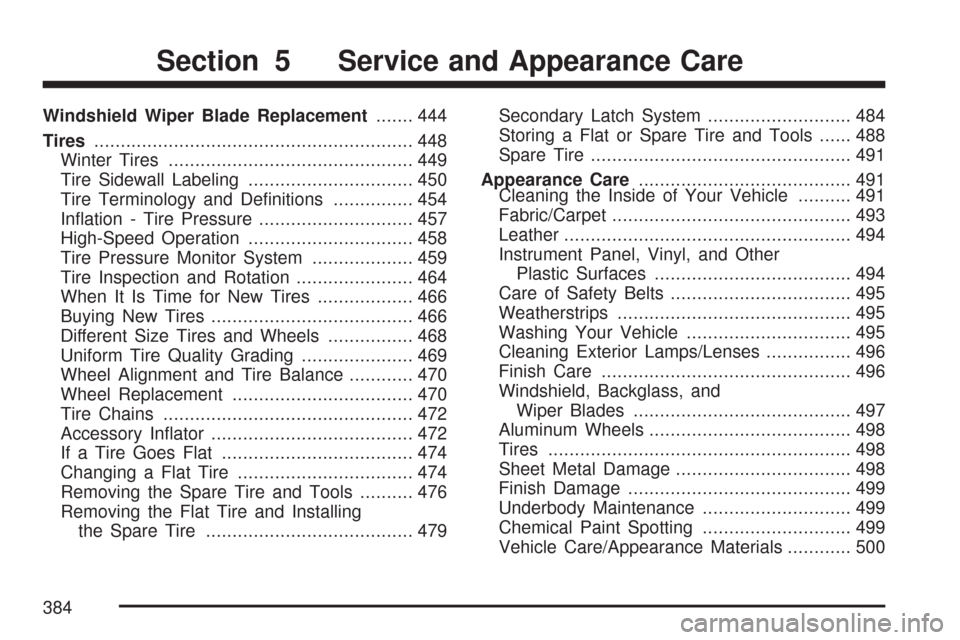
Windshield Wiper Blade Replacement....... 444
Tires............................................................ 448
Winter Tires.............................................. 449
Tire Sidewall Labeling............................... 450
Tire Terminology and De�nitions............... 454
In�ation - Tire Pressure............................. 457
High-Speed Operation............................... 458
Tire Pressure Monitor System................... 459
Tire Inspection and Rotation...................... 464
When It Is Time for New Tires.................. 466
Buying New Tires...................................... 466
Different Size Tires and Wheels................ 468
Uniform Tire Quality Grading..................... 469
Wheel Alignment and Tire Balance............ 470
Wheel Replacement.................................. 470
Tire Chains............................................... 472
Accessory In�ator...................................... 472
If a Tire Goes Flat.................................... 474
Changing a Flat Tire................................. 474
Removing the Spare Tire and Tools.......... 476
Removing the Flat Tire and Installing
the Spare Tire....................................... 479Secondary Latch System........................... 484
Storing a Flat or Spare Tire and Tools...... 488
Spare Tire................................................. 491
Appearance Care........................................ 491
Cleaning the Inside of Your Vehicle.......... 491
Fabric/Carpet............................................. 493
Leather...................................................... 494
Instrument Panel, Vinyl, and Other
Plastic Surfaces..................................... 494
Care of Safety Belts.................................. 495
Weatherstrips............................................ 495
Washing Your Vehicle............................... 495
Cleaning Exterior Lamps/Lenses................ 496
Finish Care............................................... 496
Windshield, Backglass, and
Wiper Blades......................................... 497
Aluminum Wheels...................................... 498
Tires......................................................... 498
Sheet Metal Damage................................. 498
Finish Damage.......................................... 499
Underbody Maintenance............................ 499
Chemical Paint Spotting............................ 499
Vehicle Care/Appearance Materials............ 500
Section 5 Service and Appearance Care
384
Page 464 of 574
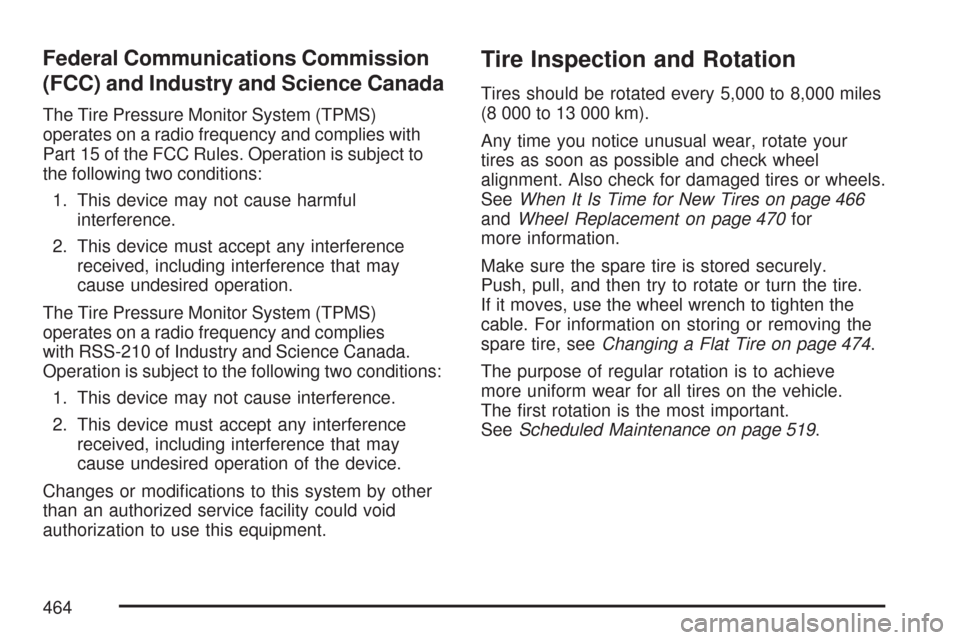
Federal Communications Commission
(FCC) and Industry and Science Canada
The Tire Pressure Monitor System (TPMS)
operates on a radio frequency and complies with
Part 15 of the FCC Rules. Operation is subject to
the following two conditions:
1. This device may not cause harmful
interference.
2. This device must accept any interference
received, including interference that may
cause undesired operation.
The Tire Pressure Monitor System (TPMS)
operates on a radio frequency and complies
with RSS-210 of Industry and Science Canada.
Operation is subject to the following two conditions:
1. This device may not cause interference.
2. This device must accept any interference
received, including interference that may
cause undesired operation of the device.
Changes or modi�cations to this system by other
than an authorized service facility could void
authorization to use this equipment.
Tire Inspection and Rotation
Tires should be rotated every 5,000 to 8,000 miles
(8 000 to 13 000 km).
Any time you notice unusual wear, rotate your
tires as soon as possible and check wheel
alignment. Also check for damaged tires or wheels.
SeeWhen It Is Time for New Tires on page 466
andWheel Replacement on page 470for
more information.
Make sure the spare tire is stored securely.
Push, pull, and then try to rotate or turn the tire.
If it moves, use the wheel wrench to tighten the
cable. For information on storing or removing the
spare tire, seeChanging a Flat Tire on page 474.
The purpose of regular rotation is to achieve
more uniform wear for all tires on the vehicle.
The �rst rotation is the most important.
SeeScheduled Maintenance on page 519.
464
Page 465 of 574
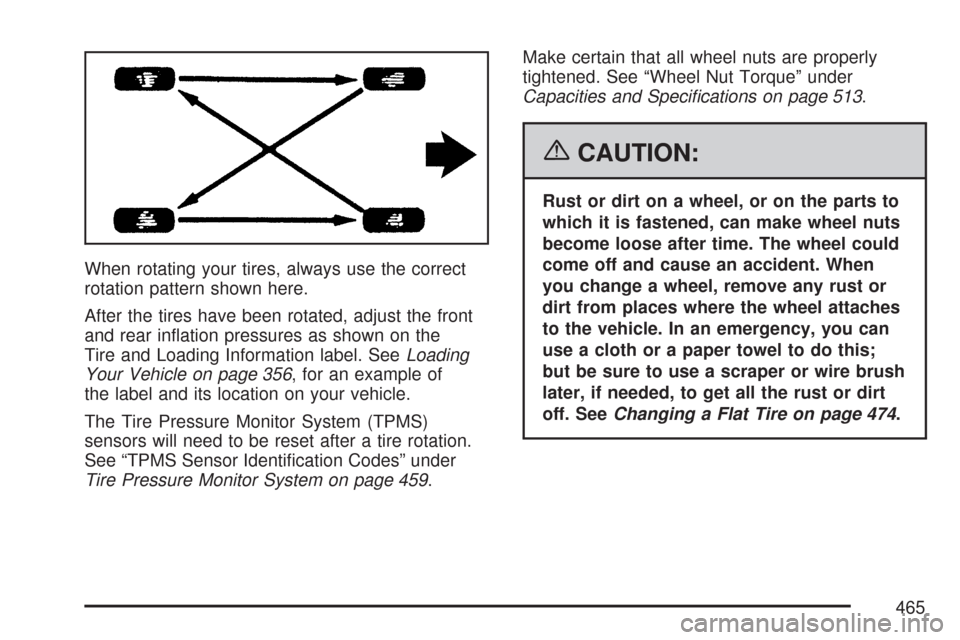
When rotating your tires, always use the correct
rotation pattern shown here.
After the tires have been rotated, adjust the front
and rear in�ation pressures as shown on the
Tire and Loading Information label. SeeLoading
Your Vehicle on page 356, for an example of
the label and its location on your vehicle.
The Tire Pressure Monitor System (TPMS)
sensors will need to be reset after a tire rotation.
See “TPMS Sensor Identi�cation Codes” under
Tire Pressure Monitor System on page 459.Make certain that all wheel nuts are properly
tightened. See “Wheel Nut Torque” under
Capacities and Speci�cations on page 513.
{CAUTION:
Rust or dirt on a wheel, or on the parts to
which it is fastened, can make wheel nuts
become loose after time. The wheel could
come off and cause an accident. When
you change a wheel, remove any rust or
dirt from places where the wheel attaches
to the vehicle. In an emergency, you can
use a cloth or a paper towel to do this;
but be sure to use a scraper or wire brush
later, if needed, to get all the rust or dirt
off. SeeChanging a Flat Tire on page 474.
465
Page 471 of 574

Your dealer/retailer will know the kind of wheel
you need.
Each new wheel should have the same
load-carrying capacity, diameter, width, offset and
be mounted the same way as the one it replaces.
If you need to replace any of your wheels, wheel
bolts, or wheel nuts, replace them only with
new GM original equipment parts. This way,
you will be sure to have the right wheel, wheel
bolts, and wheel nuts for your vehicle.
{CAUTION:
Using the wrong replacement wheels,
wheel bolts, or wheel nuts on your vehicle
can be dangerous. It could affect the
braking and handling of your vehicle,
make your tires lose air and make you
lose control. You could have a collision in
which you or others could be injured.
Always use the correct wheel, wheel bolts,
and wheel nuts for replacement.Notice:The wrong wheel can also cause
problems with bearing life, brake cooling,
speedometer or odometer calibration,
headlamp aim, bumper height, vehicle ground
clearance, and tire or tire chain clearance
to the body and chassis.
SeeChanging a Flat Tire on page 474for more
information.
Used Replacement Wheels
{CAUTION:
Putting a used wheel on your vehicle is
dangerous. You cannot know how it has
been used or how far it has been driven.
It could fail suddenly and cause a crash.
If you have to replace a wheel, use a new
GM original equipment wheel.
471
Page 474 of 574
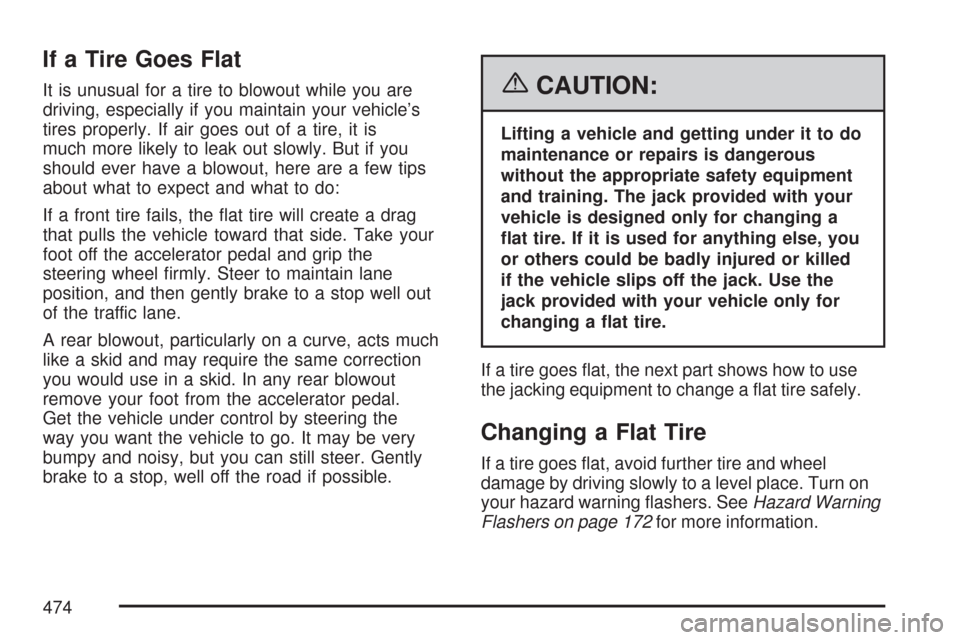
If a Tire Goes Flat
It is unusual for a tire to blowout while you are
driving, especially if you maintain your vehicle’s
tires properly. If air goes out of a tire, it is
much more likely to leak out slowly. But if you
should ever have a blowout, here are a few tips
about what to expect and what to do:
If a front tire fails, the �at tire will create a drag
that pulls the vehicle toward that side. Take your
foot off the accelerator pedal and grip the
steering wheel �rmly. Steer to maintain lane
position, and then gently brake to a stop well out
of the traffic lane.
A rear blowout, particularly on a curve, acts much
like a skid and may require the same correction
you would use in a skid. In any rear blowout
remove your foot from the accelerator pedal.
Get the vehicle under control by steering the
way you want the vehicle to go. It may be very
bumpy and noisy, but you can still steer. Gently
brake to a stop, well off the road if possible.{CAUTION:
Lifting a vehicle and getting under it to do
maintenance or repairs is dangerous
without the appropriate safety equipment
and training. The jack provided with your
vehicle is designed only for changing a
�at tire. If it is used for anything else, you
or others could be badly injured or killed
if the vehicle slips off the jack. Use the
jack provided with your vehicle only for
changing a �at tire.
If a tire goes �at, the next part shows how to use
the jacking equipment to change a �at tire safely.
Changing a Flat Tire
If a tire goes �at, avoid further tire and wheel
damage by driving slowly to a level place. Turn on
your hazard warning �ashers. SeeHazard Warning
Flashers on page 172for more information.
474
Page 477 of 574
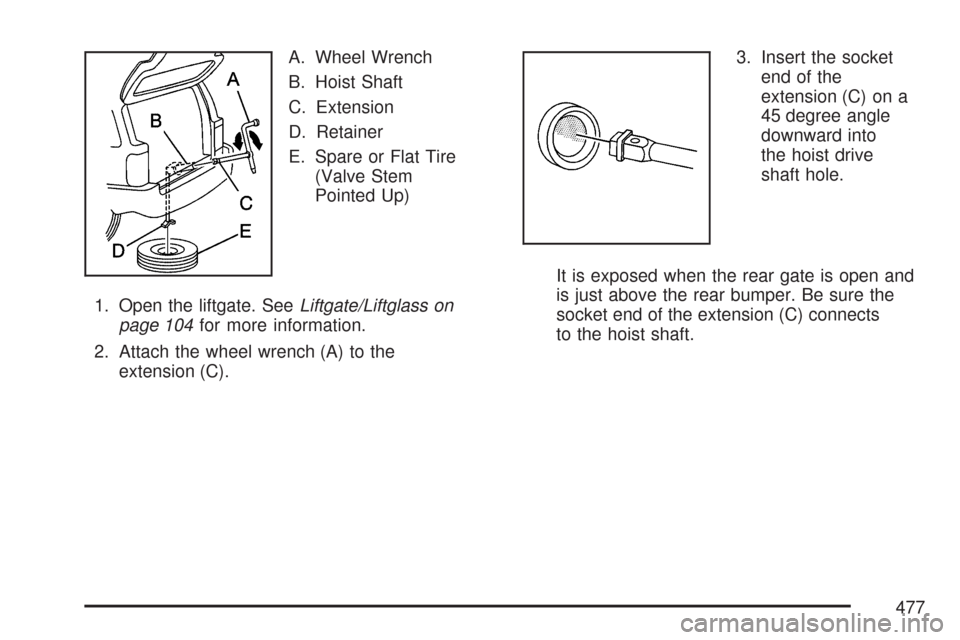
A. Wheel Wrench
B. Hoist Shaft
C. Extension
D. Retainer
E. Spare or Flat Tire
(Valve Stem
Pointed Up)
1. Open the liftgate. SeeLiftgate/Liftglass on
page 104for more information.
2. Attach the wheel wrench (A) to the
extension (C).3. Insert the socket
end of the
extension (C) on a
45 degree angle
downward into
the hoist drive
shaft hole.
It is exposed when the rear gate is open and
is just above the rear bumper. Be sure the
socket end of the extension (C) connects
to the hoist shaft.
477
Page 479 of 574
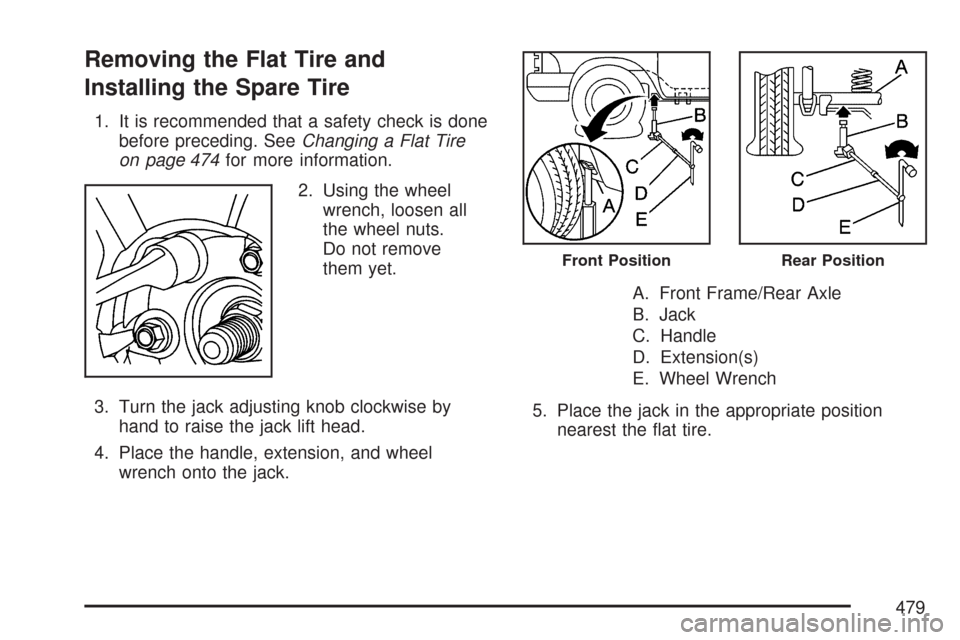
Removing the Flat Tire and
Installing the Spare Tire
1. It is recommended that a safety check is done
before preceding. SeeChanging a Flat Tire
on page 474for more information.
2. Using the wheel
wrench, loosen all
the wheel nuts.
Do not remove
them yet.
3. Turn the jack adjusting knob clockwise by
hand to raise the jack lift head.
4. Place the handle, extension, and wheel
wrench onto the jack.A. Front Frame/Rear Axle
B. Jack
C. Handle
D. Extension(s)
E. Wheel Wrench
5. Place the jack in the appropriate position
nearest the �at tire.
Front PositionRear Position
479
Page 484 of 574
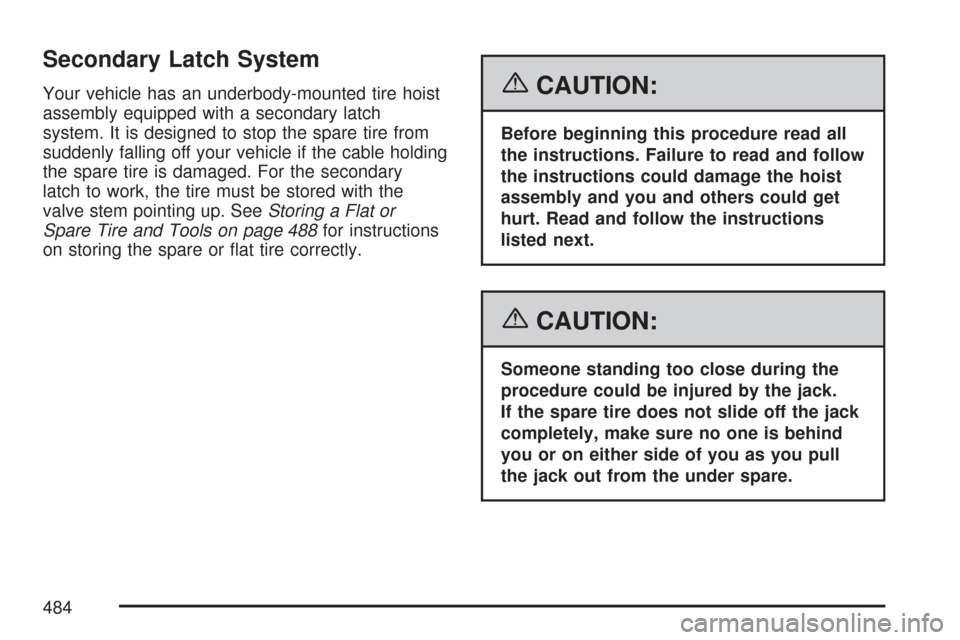
Secondary Latch System
Your vehicle has an underbody-mounted tire hoist
assembly equipped with a secondary latch
system. It is designed to stop the spare tire from
suddenly falling off your vehicle if the cable holding
the spare tire is damaged. For the secondary
latch to work, the tire must be stored with the
valve stem pointing up. SeeStoring a Flat or
Spare Tire and Tools on page 488for instructions
on storing the spare or �at tire correctly.{CAUTION:
Before beginning this procedure read all
the instructions. Failure to read and follow
the instructions could damage the hoist
assembly and you and others could get
hurt. Read and follow the instructions
listed next.
{CAUTION:
Someone standing too close during the
procedure could be injured by the jack.
If the spare tire does not slide off the jack
completely, make sure no one is behind
you or on either side of you as you pull
the jack out from the under spare.
484